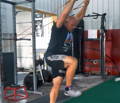Top 4 Quad Exercises for Speed
Quad strength goes a long way to improving and enhancing speed.
Now for the longest time, some sprint coaches and speed coaches thought that developing big strong quads could lead to diminishment in speed. Everything was about improving the strength and speed of the hamstrings--and this is really, really important. But it is not about the break forces that are seen from quad development--this is what a lot of sprint and strength coaches use to think.

It is important to recognize that developing stronger quads is a key component to improving overall speed. The quad improves coming out of the blocks, working through the drive phase, max acceleration, and coordinating the quads in conjunction with theglutes.
So when we are talking about developing quad strength, we have to understand the phase of where it will be: off the start and in the drive phase. When thinking about max acceleration, we can see that quad strength makes athletes more explosive and able to get out of cuts faster as a field athlete or getting out of the blocks and through the first twenty meters.
Developing quads is a key component behind sprint-based training.
1. Heavy Sled Push
This is not the hardest or the best exercise, but it does teach novice and elite athletes how to push. The heavy sled push is exactly what it sounds like. We load as much weight as possible on a sled and get into a really good position where the heels stay elevated, holding plantar flexion with no heel drop. We want to think about driving through the sled which will be heavy.

It teaches all walks of athleticism, young and old, novice and elite, how to push with the quads and coordinate with the glutes. This is a very important concept. We want a forward lean with a decently steep angle with the shins and drive forward while keeping the heel up the entire time. Now, if the heel starts to drop a ton, that means the load has gotten too heavy. We want to hold the Achilles nice and stable in the ankle so we get more recruitment from the quads and glutes.
We can have our athletes in a workout start with an Olympic lift, followed by some unilateral work, and then the heavy sled push. It will blow up the quads, teach the body to hold a stiff ankle, and this will all lead to good quad development and superior speed.
Do this exercise for three sets of ten to fifteen meters.
2. DB Elevated Split Squat W/ Slant Board
Keep in mind that these exercises are specific to developing the quads for speed, not bodybuilding.
For this exercise, we are in a split position. We want to get into a position with the front foot heel elevated on a ramp. We want the back foot elevated about 7” (use a plate). We want the front knee to get over the toes.

It is important to have good mobility in the hips and ankles. We can then hold dumbbells and hold in a farmer’s carry. Remember to have the back foot in a plantarflexed position. Travel in a full range of motion, extending the back knee to the ground. Feel free to put a pad for where the knee touches.
The reason we love using this position is that it targets the quads a ton. In addition, when talking about speed work, focusing on unilateral strength forces more dynamic trunk control. This helps the strength transfer exceptionally well to the drive phase.
Do three sets of ten reps on each leg.
3. Front Squat W/ Heel Elevated
We know a lot of coaches shy away from the front squat because of mobilityissuesand athletes struggling with trunk control. The heel elevated front squat is a little easier on the knees, really good at teaching dynamic trunk control, and spectacular at improving full ranges of motion.
We use the heel elevation to increase the range of motion. Typically we recommend using the clean catch position like an Olympic weightlifter when performing front squats, but we also accept the bodybuilder style as legitimate. It can also be done with a zombie squat, which is tougher.

We unrack the barbell and step back. We put the heels on the plate and squat down, staying nice and upright. The knees track over the toes and we squat nice and deep, grabbing with the toes while nice and controlled. Focus on coming up fast out of the hole.
This movement will teach the body how to push from the quads, squeezing the abs, gut, and midback, which will dramatically improve our control when running.
Do three sets of five to ten reps.
4. Banded Skater Squat Into Hip Lock
This last exercise requires using a band. We recommend using PowerLastic because it helps develop dynamic quad explosiveness.
We want to hook the PoweLastic band around an immovable object. We want an end of the PowerLastic in each hand. We want to see knee flexion on the back leg. We want good full foot planting on the leg that will be performing the squat. We want the back leg’s knee to aim for a pad as the front leg squats down. We will then explode through the front leg, come up, and hold the hip lock with the arms driving up.

Down in the hole, we need a good mobile ankle. This is similar to coming out of the drive phase or when focusing on acceleration. This is a great exercise to transfer over to athletics. We want to hold the hip lock for two seconds and feel it throughout the hip.
Make sure to keep the back foot up when performing skater squats with the back knee flexed to really isolate that front leg. We are really isolating that front leg to target the whole quad to improve max acceleration.
Do three sets of five reps on each leg.
Recap
When doing quad-based work or quad strength work, try to find the weakness in the phasesofrunning. Is it at the start or during the acceleration phase? If that is the area, it is most likely a quad and glute issue so utilize all four of these movements to improve the speed at the start and through acceleration. Make sure to understand how the exercises apply to the overall training and overall quad development.
DANE MILLER
Dane Miller is the owner and founder of Garage Strength Sports Performance. He works with a select handful of clients on building comprehensive programs for fitness and nutrition. Several times a year he leads a workshop for coaches, trainers, and fitness enthusiasts.


